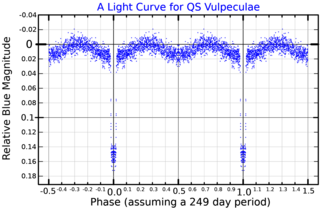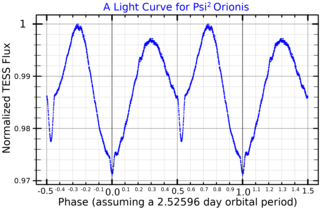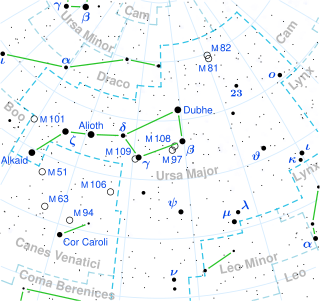
Castor is the second-brightest object in the zodiac constellation of Gemini. It has the Bayer designation α Geminorum, which is Latinised to Alpha Geminorum and abbreviated Alpha Gem or α Gem. With an apparent visual magnitude of 1.58, it is one of the brightest stars in the night sky. Castor appears singular to the naked eye, but it is actually a sextuple star system organized into three binary pairs. Although it is the 'α' (alpha) member of the constellation, it is half a magnitude fainter than 'β' (beta) Geminorum, Pollux.

18 Aquilae is a triple star system in the constellation of Aquila. 18 Aquilae is the Flamsteed designation; it also bears the variable star designation Y Aquilae. It has an apparent visual magnitude of 5.07, making it bright enough to be seen with the naked eye. The distance to this system can be estimated from the annual parallax shift of 6.43 mas, yielding a value of around 510 light-years away from Earth.
26 Aurigae is a binary star system in the northern constellation of Auriga. It is visible to the naked eye as a faint star with an apparent visual magnitude of 5.41.

Tau Canis Majoris is a multiple star system in the constellation Canis Major. It is approximately 5,000 light years distant from Earth and is the brightest member of the open cluster NGC 2362.

S Carinae is a variable star in the constellation Carina.
HD 113703, also known by the Bayer designation f Centauri, is a multiple star system in the southern constellation of Centaurus. The combined apparent visual magnitude of this system is +4.71, which is sufficient to make it faintly visible to the naked eye. The distance to this system is approximately 400 light years based on parallax measurements. It is a member of the Lower Centaurus Crux subgroup of the Scorpius–Centaurus association.

HR 2554, also known as V415 Carinae and A Carinae, is an eclipsing spectroscopic binary of the Algol type in the constellation of Carina whose apparent visual magnitude varies by 0.06 magnitude and is approximately 4.39 at maximum brightness. It is easily visible to the naked eye of a person far from brightly-lit urban ares. Its primary is a G-type bright giant star and its secondary is an A-type main-sequence star. It is approximately 553 light-years from Earth.

LY Aurigae is a multiple star system in the constellation Auriga. It is an eclipsing binary variable star, dropping in brightness by 0.7 magnitudes every 4 days. The system is around a thousand light years away in the Auriga OB1 stellar association.

R Canis Majoris is an eclipsing interacting binary star system in the constellation Canis Major. It varies from magnitude 5.7 to 6.34. The system is unusual in the low ratio between the main two components and shortness of the orbital period. It is faintly visible to the naked eye of an observer with very good observing conditions.

22 Vulpeculae is a binary star system in the northern constellation Vulpecula. Based on its parallax, it is located some 1,490 light-years away, and it has an apparent magnitude of about 5.2, making it visible to the naked eye. The system is moving closer to the Earth with a heliocentric radial velocity of −23 km/s.
Lambda Cygni is a class B5V star in the constellation Cygnus. Its apparent magnitude is 4.54 and it is approximately 770 light years away based on parallax.

47 Cygni is a triple star system in the northern constellation of Cygnus, and is located around 4,000 light years from the Earth. It is visible to the naked eye with a combined apparent visual magnitude of 4.61. The system is moving closer to the Earth with a heliocentric radial velocity of −4.6 km/s.

λ Pavonis, Latinized as Lambda Pavonis, is a single, variable star in the southern constellation of Pavo. It is a blue-white hued star that is faintly visible to the naked eye with an apparent visual magnitude that fluctuates around 4.22. This object is located approximately 1,400 light years from the Sun, based upon parallax. It is a member of the Scorpius–Centaurus association.

Gamma Phoenicis is a star system in the constellation Phoenix, located around 71.63 parsecs (233.6 ly) distant.

QZ Puppis is a class B2.5V star in the constellation Puppis. Its apparent magnitude is 4.5 and it is approximately 650 light years away based on parallax.

ZZ Boötis is a star system in the constellation Boötes. It varies from magnitude 6.79 to 7.44 over five days. Based on its parallax, measured by the Gaia spacecraft, it is about 350 light-years away.

Psi2 Orionis a binary star system in the equatorial constellation of Orion. It has an apparent visual magnitude of 4.6, indicating that it is visible to the naked eye. Based upon an annual parallax shift of 2.87 mass, it is roughly 1,100 light years distant from the Sun.

VV Orionis is an eclipsing binary located in the belt region of the constellation Orion. It is a faint naked eye star.

HO Telescopii is an eclipsing binary star system located in the southern constellation of Telescopium. The maximum apparent visual magnitude of 8.22 is too faint to be visible to the naked eye. The system is located at a distance of approximately 910 light years based on parallax. The combined stellar classification of the system is A7III(m), matching an evolved A-type star that is possibly metallic-lined. The system is around 1.1 billion years old and consists of two stars of similar mass and size.

65 Ursae Majoris, abbreviated as 65 UMa, is a star system in the constellation of Ursa Major. With a combined apparent magnitude of about 6.5, it is at the limit of human eyesight and is just barely visible to the naked eye in ideal conditions. It is about 760 light years away from Earth.

















